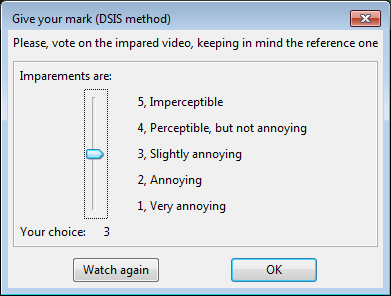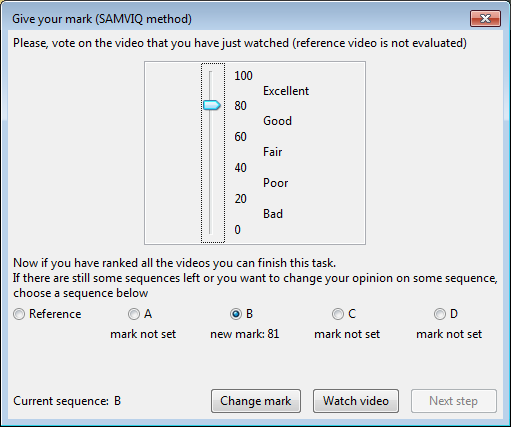
MSU Perceptual Video Quality Tool
Easy subjective video testing organization for companies and universities
MSU Graphics & Media Lab (Video Group)
Projects, ideas: Dr. Dmitriy Vatolin
Implementation: Oleg Petrov, Georgy Osipov
How to make subjective video quality comparison with MSU PVQT:
-
Collect materials for the test
We support more than 300 video formats and all main image formats
-
Choose method and create test with PVQT Editor
Now we support DSIS, DSCQS I and II, SCACJ, SAMVIQ from ITU-R BT.500 and EBU
See Methods' brief.
-
Invite observers and organize tests with PVQT Player
Observers can pass test in local network, in specially prepared room or individually. ITU-R BT.500 recommends at least 15 observers to complete the test. If you need observers to test your videos, please, mail us
-
Collect and process results
You see results in real-time in most cases. Statistical estimates as well as Bradley-Terry model results for pairwise comparison are available in PVQT
PVQT 2.1 FREE licenses period expanded: Get now!
remains to the end of BETA-testing
- How to use PVQT
- Main Features overview
- Purchase & Download
- Methods' brief
- Organization of testing
- Changelog
Download FREE BETA-testing version with limitations or Buy PRO
How to use PVQT
What is PVQT?
PVQT is a tool, developed by MSU Graphics & Media Lab. Video Group for evaluating of subjective quality (with reference or without one) of a video and image files.
The tool was developed according to ITU-R BT.500 “Methodology for the subjective assessment of the quality of television pictures”. The program does not exactly repeat the standard, as it is focused on the measurement of quality for television, but PVQT is aimed for quality measure of digital materials. Also, it has some additional features not described in the standard.
PVQT structure
PVQT consists of 2 basic parts:
- Editor (MSU PVQT) — for creating a test and collecting results (see section Creating a test in Documentation),
- Player (MSU PVQT Player) — for performing (playing) test by observer or operator in case of Network test (see section Passing a test in Documentation).
Materials selection
To create PVQT test you need one or more groups of source files. The source files can be videos or images: PVQT supports all basic video and image formats. Each group consists of different versions of one picture, which will be compared with another picture of that group. Group can have a reference. In that case all pictures will be compared to the reference. Without reference there can be pairwise comparison with SCACJ method.
ITU-R BT.500 recommends videos to be at most 10 s length. In case of images, you can tune duration that the image displays. Whole test should be no longer 30 m including voting, training questions and period between videos. You can have several sessions with breaks, each for 30 minutes. See ITU-R BT.500 for details.
Main Features overview
Purchase & Download
| File | Edition | Content | Price | Type |
|---|---|---|---|---|
| Purchase PRO version | Unlimited | Player & Editor | $490 | Windows Installer 32 & 64-Bit |
| MSU_PVQT_2.1r12323BETA_pro_64_Nov_1.exe (recommended) |
Temporary, till Jun 01 2020 | Player & Editor | FREE | Windows Installer 64-Bit |
| MSU_PVQT_Player_2.1r12323BETA_pro_64_Nov_1.exe | Temporary, till Jun 01 2020 | Player | FREE | Windows Installer 64-Bit |
| MSU_PVQT_Documentation.pdf | – | Documentation | FREE | PDF document |
video-measure@compression.ru
Methods' brief



Two videos are shown simultaneously, after playback observer is asked about his opinion.
You do not need to have references for this test. Pairwise results will be processed according to Bradley-Terry model.



Organization of testing
In this method, the test can be run by an arbitrary number of observers simultaneously or not on computers on the same local network, for example, in a computer class. The test manager can view the results in real time.
Edit and save project to location available to another computers via shared folder. You should use “Relative paths” and all videos should be also available via same shared folder or be referred in project by network path.
Multiple observers can pass test simultaneously (for example, in computer class). If Editor for this project file is opened you can see progress and results of each observer in Real-time. Also, it will display overall progress in summary.
In this method, you are sending test and videos to observers, located anywhere, who will pass the test at any time. After test is complete, observers will send you back results of testing.
To use this method, specify email in field “Result collecting e-mail”. After test is finished, observer will be asked to send a special archive (*.pvqtres) file to that email.
After you collect some archives from observers, you can import them into PVQT using “Import results from *.pvqtres file” command (project should be saved). You can import multiple files at once.
This method will be implemented in the next version of PVQT.
You choose to show the video on a large screen, for example, through a projector that is viewed by several observers. Each of them votes on their device.
Changelog
- Version 2.0 BETA
- Completely new utility
- A lot of new features
- Version 1.0
- DSCQS type II added
- Bugfixing
- Version 0.9
- DSCQS, DSIS and SAMVIQ added
- AviSynth support
MSU Video Quality Measurement Tools
Contacts
Other Resources
Video resources:
Server size: 8069 files, 1215Mb (Server statistics)
Project updated by
Server Team and
MSU Video Group
Project sponsored by YUVsoft Corp.
Project supported by MSU Graphics & Media Lab